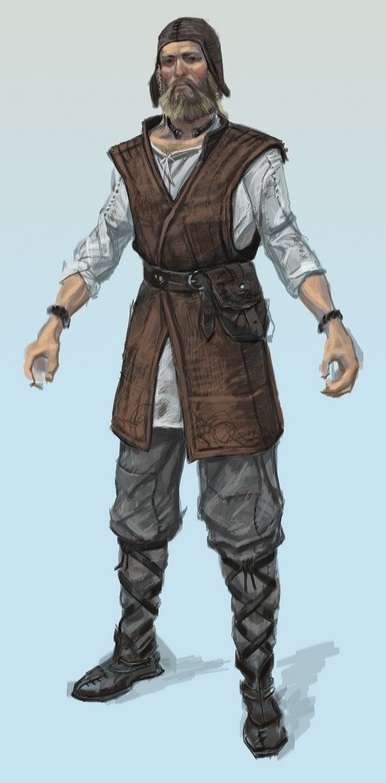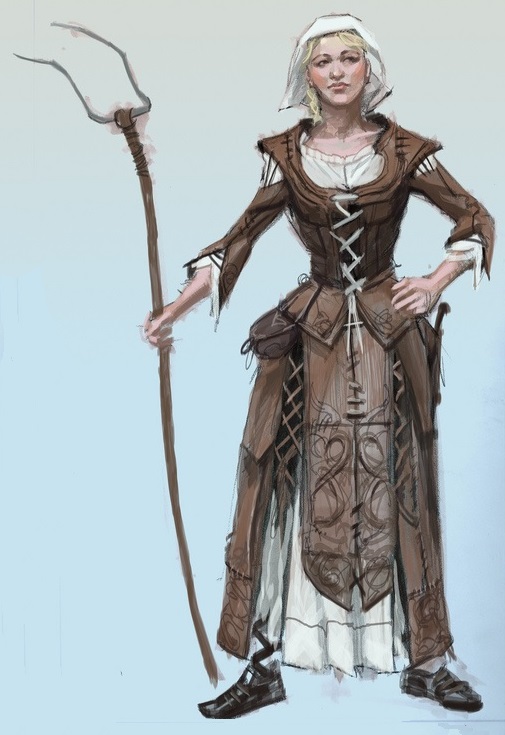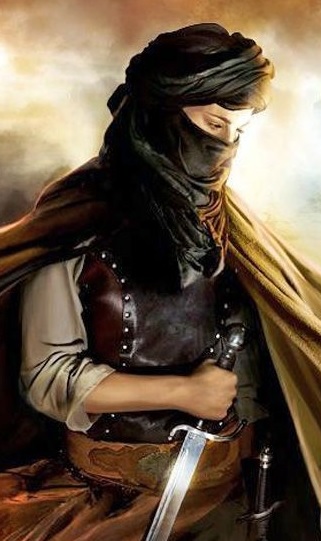Clothing
Clothing describes a wide range of subjects related to the growing and shearing of fibres, the making of cloth, fashion and regional dress. The amount and type of clothing worn relates to climate, social factors, race and gender; garments cover the body, footwear covers the feet, gloves cover the hands, while hats and headgear cover the head. Jewellery is not generally considered an item of clothing, but play an important role in overall presentation.
This page addresses primarily the subject of everyday wearables that serve as protection from the elements, harsh environments and in labour — those worn by ordinary persons and party adventurers. Descriptions below are not meant to present an accurate scholarly treatise on every form of existing Earth customs during the 17th century, but rather to provide some detail for player characters that will ground them in an overview of common dress and habit for different parts of the game world. Specific fashion choices and unique dress items can be provided for players through the equipment list, should such be desired.
Contents
Fabrics & Design
Due to a given fabric's weight and properties of insulation, sub-arctic climates prefer a mix of fur and leather for warmth; temperate climates prefer woollens; warm temperate areas and sub-tropics tend towards linen and cotton; while tropical climates will tend towards much less clothing with open woven fibres such as hemp or ramie. Silk is more common in the Far East than anywhere else, though parts of Europe have by the 17th century acquired silk worms and transplanted mulberry trees.
In colder seasons, clothing tends to be layered and pressed tight to the figure, in order to form air pockets inside the clothes that are warmed by the body, serving as insulation. Loose-fitting clothes with less layers predominate in warmer months. However, in extremely hot climates, particularly in the desert where protection against the sun is desperately needed, an inner layer of muslin cotton is adopted so that the body's sweat will produce a continuously wet insulation layer between the body and the harsh dry temperature. This is less needed in wet tropical areas, where humidity is high and vegetation growth produces considerable shade; thus in wet tropics, virtual nakedness is practical.
European Dress
Common People
The male dresses in a short trouser around his bottom; this hangs to the knee and takes the place of a loincloth. The shirt is loose-fitting and pulled over the head, laced in the upper part. Woolen stocking pants, soft and thick, pull up to the waist; this includes a flap of fabric called a "codpiece" preserves modesty. Overtop the shirt, a doublet — essentially a jacket — is added, with laces that sew the jacket to the hose, holding up the latter. A robe fits across the shoulders and hangs to the knees; the front is worn open, so that the doublet's visible, with the robe tied at the waist. A workman would wear an apron. In rough weather or for general travel, a cloak, with or without a "mantle" (extra cloth over the shoulders) and a hood is worn over the rest. Low boots to the ankles, or high boots to the knees, and a durable hat completes the wardrobe.
The female begins with a chemise, a simple, linen sleeved-smock that hangs to her knees and is worn without undergarments – practical, as the woman must always squat when she goes. A frock is worn over the gown, and sometimes more than one for warmth; this is pulled on, over the head. A belt ties at the waist over the dress, giving the garments shape. Gathers, pleats or tocks are a waste of fabric for peasants. An apron might be worn, or she might tie a large kerchief about her waist as something on which to wipe her hands. She wears long woollen stockings that come to the tops of her thighs; these are bound in place, so they wouldn't fall down, by garters of cloth strips, or woven beneath the knee. The stockings fit in short boots. She binds her hair with a wide headcloth, then fits a kerchief or cap overtop the cloth so that her hair isn't visible. This cap is pinned in place. Women, like men, don a cloak in poor weather or for travel.
Layers are reduced in lower latitudes, with wool cloth being replaced by linen or cotton. Long sleeves are replaced with shorter sleeves or sleeveless garments. The doublet is dispensed with, or worn without the shirt. The robe, with cowl, is kept for wet weather and the cloak is abandoned entirely, except for festivals. Workmen often wear an apron over no shirt at all. Women discard the chemise and the surcoat becomes less important. Her hair may be worn freely, tied back and allowed to breathe.
Adventurer
The man's shirt is made of a better fabric, likely linen. The doublet has slashed sleeves, showing bits of the shirt poking out. This allows greater movement and attractiveness; the doublet itself is made of felt, velvet or serge, and is usually lined on the inside. A wide, polished leather belt ties the robe together, with a second belt added over the shoulder for weapons, especially a quiver. This may be complimented by a third belt over the other shoulder. Cloaks tend to have a mantle, and will be replaced with capes in warmer climes. -high boots are greatly preferred over short, with thigh-high leather boots being common.
For the woman, the chemise is also improved in quality and has voluminous sleeves. Instead of a simple frock, she wears a "kirtle," a lined-dress that laces to the chin, laces in the back to give shape and has slashed sleeves like the male's doublet. The kirtle is molded to the woman's body and gives superior freedom of movement; it is made of felt or damask and generally has wide neck. A torsolette laces above the mid-section so as not to infringe movement, securing the bosom tightly. Her head is free, with her hair braided or bound with a cord.
Both male and female will wear gloves, often gauntlets, and polished leather boots rather than rough hide. Knee-high boots are greatly preferred over short, with thigh-high leather boots being common. Clothes have to be especially durable, since they are often surmounted by armour and abraised with weapons. An "arming jacket," a loose robe that's worn overtop armour, is often fitted to rings at the shoulders and tied with a belt.
Greater flexibility in fabrics and designs are expected for different parts of Europe, due to the adventurers' greater wealth and exercising of tastes. Thus, the adoption of different, practical wear is supposed, such as a short jacket rather than a robe; a wide-brimmed hat designed to keep off the rain instead of a cloak, especially during the summer; or pantaloons and breeches instead of stockings, especially for backcountry wooded exploration. Lighter clothes may be worn where the adventurer expects to spend long days in hauberk and chausses. There is of course the addition of embroidery, sigils, heraldic motifs, application of dyestuffs and jewellery to be considered, as these things become part of the adventurer's wardrobe through success and plundering.
Ottoman Dress
Unlike Europeans, Turkish men continue the use of a loin cloth in the manner that it's been wound for thousands of years. Over this, they wear a pair of baggy trousers called a "salvar," which are tight at the ankles. Instead of a shirt, the Turk wears a "mintan," a sleeveless shirt that ties in front, and over this, a "zibin," or hip-length vest. A common man may not be able to afford both, while a peasant may wear only a zibin while labouring. In colder weather, a caftan — possibly fur-lined — is worn over all, and never a cloak. Leather sandles called "yemeni" fit on the feet. The head must be covered; this is usually done with a turban, or "sarik," which is a cloth wrapped around the head. The "fez" is apocryphal for the period. Clothes are made of of wool or cotton, depending on the time of year. An adventurer's version will be dyed and embroidered, possibly with gold or silver brocade sewn into the fabric; a sash is always included, worn to conceal a belt for weapons. The zibin may be made of silk.
Everyday wear for women also includes a salvar, with a loose-fitting shirt called a "gomlek," that reaches to mid-thigh. The woman's zibin is worn over this, with a belt tied around the gomlek's waist. Adventuring women who participate less in combat — spellcasters & thieves — will also wear an entari, which is similar to a kaftan except that it's open at the front, leaving the garment to gape open over the bust. A combatant would wear a "ferace," a tight robe that's buttoned up to the throat. A muslim adventuress may wear a yashmak, or veil of muslin cotton or mesh, covering her mouth, nose and forehead, with large openings for the eyes and leaving the throat uncovered to permit better breathing.
The kaftan is heavily padded, replacing the European hauberk & chausses, with metal armour being rarely worn due to the climate. Islamic law does not permit heraldic symbols for identity, so patterns are geometric in form.
Persian Dress
Similar to Ottoman dress, with important differences, relating to Persia having a drier climate. For men, the salvar is called a "shalvar" in Persia; these baggy trousers are more voluminous and merely gathered at the ankles rather than being tight. The "pirahan" replaces the mintan; this wide jacket falls straight to the knees, with loose sleeves to the wrists. Overtop is worn a colourful short-sleeved robe, belted at the waist. Bright colours are overall more important to the Persian — particularly lapis blue, emerald green and tomato red. The adventurer wears a belt made of floral metal fastenings, with motifs of silk and gold brocaded fabrics. Flower-motifs are far more common than geometric designs.
The woman likewise wears a shalvar, and the pirahan also, but overtop the latter she wears a waist-hugging jacket with tight sleeves to her wrists, open at mid-chest to accentuate her bosom. The adventuress replaces this jacket with an over-tunic that laces around the torso to the throat and includes a skirt that flares around the ankles. Her hair is worn long and collected into multiple braids; there is less expectation that her face will be draped in an enveloping veil, or "chador," though she will commonly choose to veil and conceal her identity when at leisure.
Typically, padded and metal armour isn't worn in the region due to the extremes of heat and cold, since Persia has a continental climate. Forms of leather armour that incorporate elements of the Persian's outerwear are more popular than ordinary pieces of leather; virtually every suit is made specifically for the wearer, a process that requires about two weeks.
Hindi Dress
This describes primarily dress worn by Hindus of the Indian subcontinent. Moghul Islamic dress incorporates elements of both Hindu India and Persian dress, described above.
Among the multitude, men wear a "pajama," a shirt-and-trouser combination made of soft, lightweight cotton, which breathes well in a humid climate and dries easily during the wet season. Trousers tie at the waist, while the shirt pulls over the head, has an open neck and short sleeves without cuffs. A variant is the churidar, also worn by women; worn in south India, the trousers fit tightly to the legs, made of cotton that may be stretched and fitted to the leg with horizontal folds called "bangles." This extra cloth eases, making it possible for the wearer to bend the knees and sit comfortably. The head is shaved or cut very short. Varying jewelry and embroidered slippers are embraced by both sexes.
Women traditionally wear the "kurti," which is a short, mid-thigh length tunic, with a "gharara," a pair of wide-legged pants that are ruched at the knees so that they flare out dramatically. The northwest subcontinent favours the "sari," which is wrapped around the whole body, one of the ends being thrown over the right shoulder. The hair is worn under a veil that leaves the face free.
The heat and humidity of the subcontinent makes virtually any heavy clothing, especially armour, impractical. Adventurers tend to adopt forms of Islamic dress, with a turban, or an "achkan," a knee-length jacket that's heavier and tighter than the Persian pirahan, worn over the pajama — once the under pajama is soaked wet with sweat, the jacket is both durable and comfortable even in hot weather.
Chinese Dress
China Proper
During the time period represented by the game world, both men and women wore voluminous clothing — a long robe with wide sleeves for men, a shorter robe worn over a wide skir for women. Except in the north, which adopted a Mongolian-Manchu form of dress, cotton had become the characteristic fabric worn by Chinese peasants and workers, with batting used for padding in winter garments. Artisans tended towards an indigo-dyed cotton jacket worn over calf-length trousers for men or a skirt for women.
Adventurers wore the dragon robe, "yuanlingshan," regardless of sex; a rigorous gown with a rounded collar, worn as an outer robe and belted at the waist. This flared out just below the knees and covered the arms loosely, narrowing at the wrist. Made of tightly woven padded silk, the effect provided the equivalent of padded armour; leather or metal armour would be worn overtop in Western China, where high altitudes and cooler climates made this possible. On the lowlands, no other armour was worn. Heavy booted slippers and a high rounded cap were traditional.
Manchu China
In the colder north of China, men wore the "changshan," a long jacket robe that buttoned from the waist to the neck. This is made of silk over a lining of wool. In southern parts that have begun to copy the Manchu dress — following the domination of the Manchu's rule over China — the wool is replaced with cotton. Beneath the jacket, men wear the long skirt of the Han dynasty, reaching to the ankles. The arrangement worn by women is similar; the qipao is a high-necked, closely fitted and often short-sleeved dress; again, the Han skirt is worn beneath this.
Regardless of dress, overtop of these described clothes the adventurer wears the "magua," a waist-length jacket with short, wide sleeves, tied with a wide leather belt; the effect functions much like a riding jacket.


